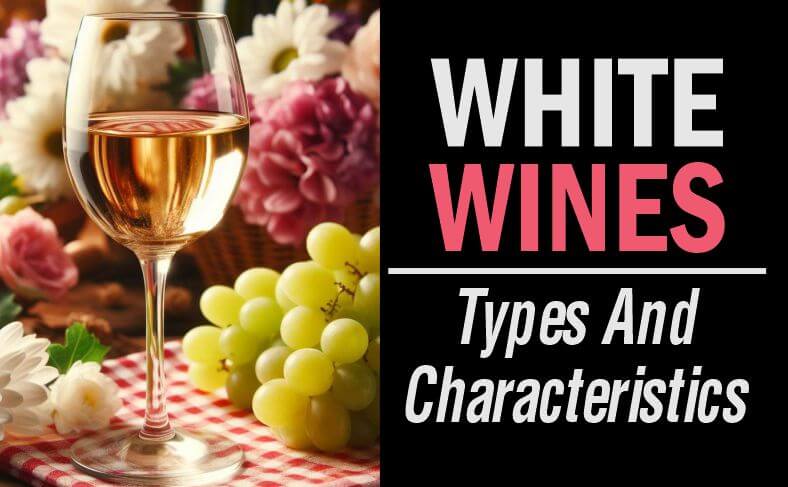Discover everything you need to know about white wines – different types and characteristics, from crisp and refreshing to creamy and rich.
White wines are a popular choice among wine enthusiasts around the world.
With their crisp flavours, refreshing acidity, and versatility, they offer a wide range of options to please all palates.
The light-bodied nature of the white beverage makes them enjoyable on their own or as an ideal accompaniment to various cuisines and occasions.
They pair well with a multitude of dishes, including seafood, poultry, cheeses, and salads.
From the zesty Sauvignon Blanc to the buttery Chardonnay, white wines cater to different preferences and their versatility ensures that there is a white wine to suit every taste and occasion.
In this article, we have detailed everything to know about white wine, including the characteristics, types, and regions the grapes grow.
Related: Understanding the Sparkling, Fizzy Wine
Recommended: What is Wine Appreciation?
Table of Contents
- History and Production of White Wines
- Types of Whine Wine Based on Flavour
- Types of White Wine Based on Body
- Types of White Wine Based on Type of Grape
- White Wine Making Process
- Characteristics of White Wines
- Regions of White Wine Production
- White Wine Aging and Storage
- Frequently Asked Questions
- Final Word from Gentsways
Suggested: The Rosé Wines
History and Production of White Wines

Origins
The origins of white wine can be traced back to ancient times.
Just like the red wines, it is believed that the first of its kind was produced in the region that is now modern-day Georgia, around 6,000 BC.
From there, the production and consumption spread throughout the Mediterranean and eventually reached Europe.
The white beverage became popular during the Roman Empire, and vineyards were cultivated in various regions, including France, Italy, and Germany.
Related: The Different Types of Wines
Types of Whine Wine Based on Flavour
Dry White Wines
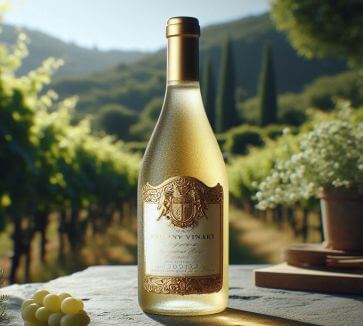
Dry white wines have little to no residual sugar, meaning they are not sweet.
These wines are fermented until most of the sugar is converted into alcohol by the yeast.
As a result, the dry wine tends to have a crisp and refreshing taste with a higher acidity.
They are often characterized by flavours of citrus, green apples, and minerals.
Dry whites are versatile and pair well with a wide range of foods, including seafood, poultry, and light pasta dishes.
Related: The Red Wine and its Subtypes
Sweet White Wines

Sweet whites, on the other hand, have a significant amount of residual sugar.
This sugar can come from the grapes themselves or be added during fermentation to achieve the desired sweetness.
Sweet white wines tend to be rich, luscious, and fruity in taste.
They can have flavors of ripe fruits like peach, apricot, and honey.
These wines are often enjoyed as a dessert wine or paired with desserts such as fruit tarts, cheesecake, or crème brûlée.
Related: Wine Etiquette for Gentlemen
Types of White Wine Based on Body
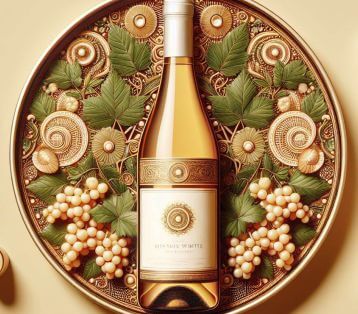
Many wine enthusiasts and novices alike may not be aware that there are four different types of white wines based on the body (weight) – each with its unique characteristics and flavours.
- Light-bodied whites
- Medium-bodied whites
- Full-bodied whites, and
- Dessert whites
1. Light-bodied Whites
Light-bodied white wines are known for their delicate and subtle flavours.
They typically have lower alcohol content and are best served chilled.
Some popular examples of light-bodied whites include Sauvignon Blanc and Pinot Grigio.
Sauvignon Blanc is often associated with grassy notes, green apple, and citrus flavours, making it a popular choice for those who prefer a lighter and more zesty white wine.
Pinot Grigio, on the other hand, offers a crisper and fruitier taste with hints of pear and melon.
Related: Regions of Wine Production Around the Globe
2. Medium-bodied Whites
Medium-bodied types strike a balance between the lightness of their lighter counterparts and the richness of the fuller-bodied whites.
Chardonnay is the most well-known medium-bodied white, and it is often associated with buttery and creamy flavours.
Its versatility allows it to pair beautifully with a wide range of dishes, making it a favorite among wine enthusiasts.
Other examples of medium-bodied whites include Riesling, Chenin Blanc, and Viognier.
Related: Guide to Pairing Wines and Salmon
3. Full-bodied Whites
Full-bodied white wines are characterized by their rich and intense flavours.
They typically have higher alcohol content and can be aged to enhance their complexity.
Chardonnay also falls into the full-bodied category, but oaked versions are particularly known for their full-bodied profile, with notes of vanilla, toast, and caramel.
Other examples of full-bodied whites include Gewürztraminer, Sémillon, and Marsanne.
4. Dessert Whites
Dessert whites, as the name suggests, are wines typically served after a meal as a sweet treat.
These wines contain residual sugar, giving them a naturally sweet taste.
Examples of dessert whites include Moscato, Sauternes, and Ice Wine.
Moscato is a delightful and aromatic wine with flavours of peach, apricot, and orange blossom.
Sauternes, often referred to as liquid gold, is a French wine known for its intense sweetness and rich flavours of honey, apricot, and caramel.
Ice Wine, on the other hand, is made from grapes that are left on the vine to freeze and produce concentrated sugars, resulting in a luscious and honeyed taste.
Related: Wine Pairing Guide for Gentlemen
Types of White Wine Based on Type of Grape
White wines also come in a wide array of grapes, each with its own unique characteristics and production methods.
Let’s explore some popular types bordering on the type of grape:
Chardonnay Wine and its Grapes
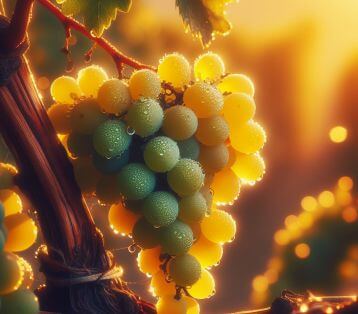
Chardonnay is one of the most widely recognized white wine varieties in the world.
It is gotten from one of the most widely planted and versatile white grape varieties.
It can produce a wide range of styles, from lean and crisp to rich and buttery, depending on factors like climate and winemaking techniques.
Chardonnay grapes are grown in various regions, including Burgundy in France, California in the United States, and Australia.
Related: Tips on Pairing Ham with Wines
2. Sauvignon Blanc Wine and its Grapes
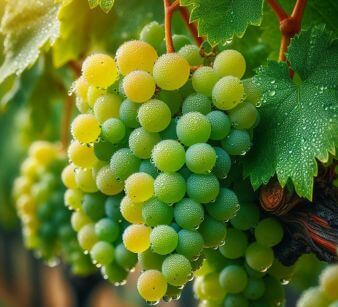
Sauvignon Blanc is celebrated for its refreshing acidity and intense aromatics.
It often exhibits notes of citrus fruits, green apples, and fresh-cut grass.
Sauvignon Blanc grape is grown worldwide, with notable regions being Marlborough in New Zealand, Sancerre in France, and Napa Valley in California.
Related: Guide to Wine and Lamb Combo
3. Riesling Wine and its Grapes

Riesling is revered for its aromatic expressions and high acidity.
Riesling is a German grape variety that can produce wines with varying levels of sweetness, from bone dry to lusciously sweet.
It is known for its aromatics, high acidity, and ability to age well and also for its ability to showcase the terroir in which it is grown, resulting in a wide spectrum of flavours ranging from dry to sweet.
Riesling grapes are primarily grown in Germany, Alsace in France, and the Finger Lakes region in New York.
Related: Sparkling Reds: Characteristics and Pairing
4. Pinot Grigio/Pinot Gris Wine and its Grapes
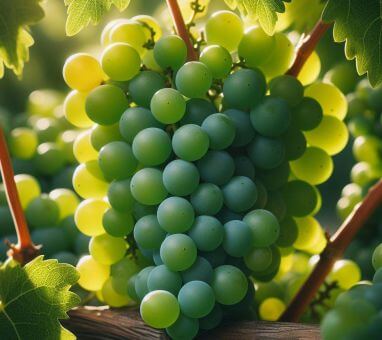
Pinot Grigio and Pinot Gris are different names for the same grape variety.
It is a popular grape variety in Italy, particularly in regions like Friuli-Venezia Giulia and the North-Eastern region of Veneto.
It typically produces light and crisp wines with citrus and stone fruit flavours.
This white wine is known for its light-bodied nature and subtle flavours often reminiscent of pear, apple, and lemon.
5. Viognier
Viognier is renowned for its opulent and aromatic characteristics.
It often exhibits flavours of stone fruits like apricot and peach, accompanied by floral notes.
Viognier grapes are primarily grown in the Rhône Valley in France, but can also be found in California and Australia.
6. Gewürztraminer
Gewürztraminer is known for its intensely aromatic profile, displaying floral characters, lychee, and spicy notes.
It pairs exceptionally well with Asian cuisine due to its inherent exotic flavours.
Gewürztraminer is most prominently cultivated in Alsace, France, as well as in Germany, New Zealand, and California.
These are just a few examples of the grape varieties used for white wines, but numerous others contribute to the wide variety of styles and flavours available in the white beverage.
White Wine Making Process
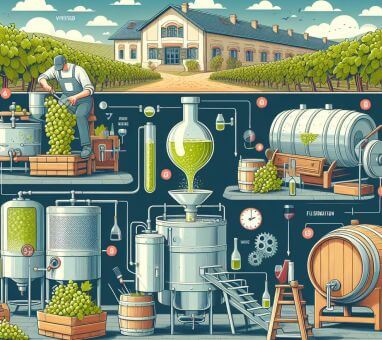
The winemaking process for white wines differs from that of red wines.
Generally, the whites are made from the juice of grapes, while red wines are made from the juice and skins of the grapes.
After the grapes are harvested, they are typically crushed to release the juice.
In some cases, the juice might be left in contact with the skins for a short period to extract more flavour and aroma compounds.
However, this is not as common for white wines compared to red wines.
Once the juice is obtained, it undergoes a process called clarification to remove any impurities.
This can be done through settling, filtration, or the addition of fining agents.
Fermentation
After clarification, the juice is fermented. Depending on the desired style of the wine, the fermentation can take place in stainless steel tanks or in oak barrels.
Fermentation converts the sugar in the juice into alcohol, creating the base for the wine.
Aging, Blending and Stabilization
After fermentation, the wine can go through additional processes such as aging, blending, and stabilization.
Aging can occur in stainless steel tanks, oak barrels, or a combination of the two.
Ageing allows the wine to develop complexity and enhance its flavours.
Blending may also take place, especially if the winemaker wants to create a specific flavour profile or balance the characteristics of different grape varieties.
Finally, stabilization processes ensure that the wine is ready for bottling by removing any remaining sediments or impurities.
White Wine Grapes
The wine can be made from a variety of grape varieties, each imparting its own unique characteristics.
Some of the most popular grape varieties used for the production of the wine include Chardonnay, Sauvignon Blanc, Riesling, Pinot Grigio, and Gewürztraminer.
Characteristics of White Wines

The whites are known for their refreshing and vibrant characteristics.
Let’s take a closer look:
1. Color: White wines can range in color from pale straw to golden yellow. However, some wines such as Chardonnay, can have a deeper golden color.
2. Aromas: They often exhibit a wide range of aromas, which can vary depending on the grape variety and winemaking techniques. Common aromas include citrus fruits (lemon, lime, grapefruit), stone fruits (peach, apricot), tropical fruits (pineapple, mango), and floral notes.
3. Acidity: They generally have higher acidity levels compared to red wines. This acidity brings a refreshing and crisp sensation to the palate, making them a popular choice for warm weather or as an aperitif.
4. Light to Medium-bodied: The whites are typically lighter in body compared to red wines. However, some varieties like Chardonnay can be medium to full-bodied, depending on factors like the winemaking process and oak aging.
5. Varietal Expression: They showcase the characteristics of the grape variety from which they are made. Different grape varieties, such as Sauvignon Blanc, Riesling, and Chardonnay, have distinct flavours and aromas that add diversity to the world of white wines.
6. Versatility: They are known for their versatility when it comes to food pairing. Their acidity and lighter body make them an excellent match for a wide range of dishes, including seafood, salads, poultry, and light pasta dishes.
7. Refreshing and Crisp: One of the defining qualities of the white type of wines is its freshness. The crisp and clean nature makes them an appealing choice for those seeking a lively and invigorating drinking experience.
8. Temperature: The white wines are typically served chilled, ranging from 45°F to 55°F (7°C to 13°C), to accentuate their refreshing characteristics. However, certain fuller-bodied varieties, like oaked Chardonnay, may be served slightly warmer to enhance their aromas and flavours.
Regions of White Wine Production
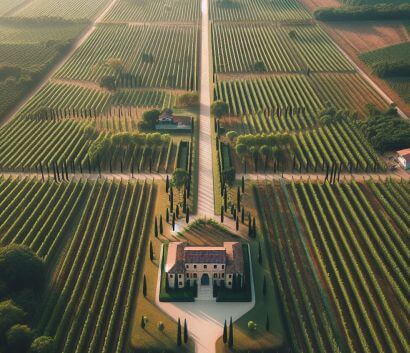
White wine production is not limited to one region or country, with many regions across the globe producing exceptional examples of this delightful beverage.
Some notable regions include:
1. Burgundy, France: Burgundy is renowned for producing high-quality Chardonnay wines, particularly from the villages of Chablis, Meursault, and Puligny-Montrachet. These white wines often have a balanced acidity, delicate fruit flavors, and a unique mineral character.
2. Alsace, France: Alsace is known for its aromatic wines, including Riesling, Gewürztraminer, and Pinot Gris. These Alsace wines are full-bodied, rich in flavor, and typically have a hint of sweetness.
3. Marlborough, New Zealand: Marlborough has gained international recognition for its Sauvignon Blanc wines. These wines showcase vibrant acidity, tropical fruit flavors, and distinctive herbaceous notes, thanks to the region’s cool climate and unique terroir.
4. Mosel, Germany: The Mosel region in Germany is renowned for producing world-class Riesling wines. The steep slopes of the Mosel River provide excellent growing conditions, resulting in aromatic, high-acid
White Wine Aging and Storage

White wine aging potential is how well a white wine can develop and improve in flavour, aroma, and complexity over time.
Unlike red wines, which generally have higher aging potential, most whites are meant to be enjoyed while young and fresh.
They are known for their vibrant fruit flavours, acidity, and freshness, which can diminish with extended aging.
Storage Conditions
Proper storage conditions for white wines are essential to maintain their quality and prevent premature aging or spoilage.
Here are some important factors to consider:
1. Temperature: White wines should be stored at a consistent temperature between 45-55°F (7-13°C). Avoid temperature fluctuations, as they can cause the wine to deteriorate quickly. High temperatures can speed up aging, while low temperatures can slow down the aging process.
2. Humidity: Maintain a humidity level between 50-80%. Lower humidity can dry out the cork, leading to oxidation, while higher humidity can promote mold growth. Proper humidity levels help to prevent premature aging and protect the wine inside the bottle.
3. Light: They are more sensitive to light than red wines. UV rays can degrade wine, leading to unpleasant aromas and flavours. Store in a dark place or use UV-filtered lighting if necessary.
4. Position: Store the wines horizontally to keep the cork moist and prevent it from drying out. This ensures an airtight seal, keeping the wine fresh.
5. Vibration: Avoid storing white wines in areas with constant vibration, as it can disturb the wine and negatively impact its aging process.
White Wines that Benefit from Aging
While most of these wines are best enjoyed young, some higher-quality whites can benefit from aging.
These include:
1. Chardonnay: High-quality Chardonnay wines from regions like Burgundy and California can develop increased complexity and richness with age.
2. Riesling: Certain Riesling wines, especially those from Germany, can age well and develop honeyed and petrol-like characteristics over time.
3. Sauternes: These sweet wines from Bordeaux, like Château d’Yquem, can age for decades, developing more intense flavors of honey, dried fruits, and caramel.
4. White Rioja: White Rioja wines made from Viura grape can age gracefully, gaining complexity and nutty flavours with time.
Frequently Asked Questions
What are the characteristics of white wine?
Characteristics of white wine include light color, often dry or slightly sweet taste, refreshing acidity, and a wide range of flavors like citrus, floral, and tropical fruits.
What are the four types of white wine?
The four types of white wine are Chardonnay, Sauvignon Blanc, Riesling, and Pinot Grigio/Gris.
What are the common types of white wines and their characteristics?
Chardonnay: Full-bodied with flavors of citrus, butter, and oak.
Sauvignon Blanc: Crisp and refreshing with notes of green apple, citrus, and tropical fruits.
What is the difference between dry and sweet white wines?
Dry wines have minimal residual sugar, offering a more crisp and acidic taste. Their sweet cousins contain higher residual sugar, resulting in a sweeter and fruitier flavour profile.
Final Word from Gentsways
White wines offer a diverse range of types and characteristics that cater to various preferences.
From crisp and light-bodied options like Sauvignon Blanc to rich and full-bodied varieties like Chardonnay, there is something for everyone.
Whether it’s the zesty notes of citrus and green apple, or the creamy texture and flavours of butter and vanilla, the wines provide a delightful sensory experience.
It is their refreshing nature and ability to complement a wide array of foods that make the wines a popular choice among wine enthusiasts.
References:
- https://www.askmen.com/fine_living/wine_dine_archive_300/359_white-wines-men-should-drink.html
- https://www.goodpairdays.com/guides/wine-101/article/white-wine/
- https://winefolly.com/deep-dive/beginners-white-wines-list/
- https://winepigeon.com/white-wine/
Pyo Merez is a men’s lifestyle enthusiast and writer about the gentleman’s place and impact on society. Raised by a distinguished gentleman dad, he offers unique insights into how the mind of a gentleman works and how societal norms shape gentlemen’s identity and vice versa.
Through his insightful articles, Pyo taps into the depths of gentleman culture to provide perspectives on etiquette and manners in modern society.

